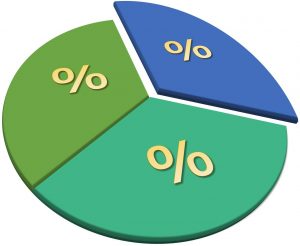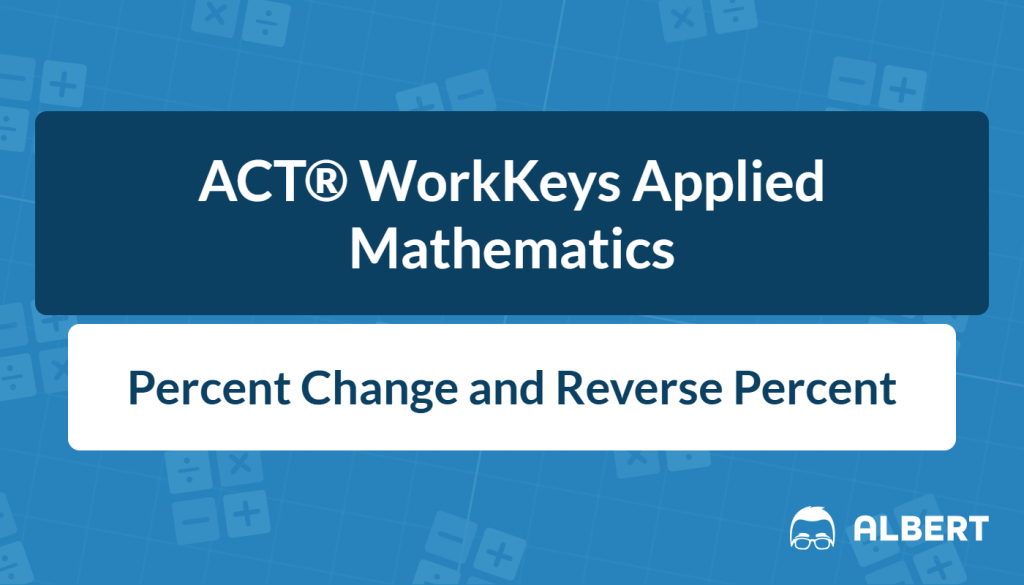Understanding math concepts like percent and percent change can be challenging, but they are helpful in daily life. These ideas are especially important for high school students preparing for the ACT® WorkKeys Applied Math Test. Percent change is a basic tool used in finance, sales, and statistics. It helps you look at data and make smart choices. Reverse percent helps you find the original amount when you know the percent change and the new value. By the end of this guide, you will understand both percent change and reverse percent, helping you with tests and everyday situations.
What We Review
Understanding Percent and Percent Change
The term “percent” refers to expressing a quantity as a fraction of 100. In simpler terms, when we use the word “percent,” we indicate how many parts out of a total of 100 parts we are considering. For example, if we say 25 percent, we are looking at 25 parts out of a complete set of 100.
What is Percent Change?

Percent change measures how much a value has gone up or down by comparing the new value to the original value, expressed as a percentage. This metric is commonly used in finance, statistics, and many other fields, highlighting the importance of accurate data analysis.
Calculating percent change allows us to easily identify trends in data. It’s especially helpful for monitoring market prices and managing budgets. By understanding percent change, we gain valuable insights into how values fluctuate over time, which can guide individuals and businesses in making informed decisions.
Percent change can indicate both increases and decreases. A positive percent change indicates an increase, showing how much a value has risen compared to its original amount, while a negative percent change signifies a decrease, revealing how much a value has fallen.
The Percent Change Formula
The percent change formula calculates how much a value has increased or decreased by comparing the difference between the new value and the original value to the original value and then expressing that difference as a percentage. This helps us understand the change in relation to the starting point.
To calculate percent change, use this formula:
\text{Percent Change} = \left( \frac{\text{new value} - \text{original value}}{\text{original value}} \right) \times 100
Calculating Percent Increase
To find the percent increase, calculate the change in value using the percent change formula. A positive result shows that the value has increased. For instance, if a product’s price goes from $50 to $60, the percent increase tells customers how much more they will pay.
Calculating Percent Decrease
A percent decrease occurs when a value goes down from its previous amount. You can use the same formula for percent change, but the result will be negative to show a decrease. For instance, if a service fee drops from $100 to $80, the percent decrease shows how much you save.
Common Mistakes and Tips
Calculating percent change is easy, but mistakes can give you wrong answers. Being careful can improve your math skills.
Here are some common mistakes:
- Mixing up the original value and the new value.
- Forgetting to divide by the original value, which is necessary for the calculation.
Always change your final answer into a percentage by multiplying by 100.
Tips to Remember the Formula
To help you remember the percent change formula, think: “New minus Original, Divide by Old, Times One Hundred.” Practicing different problems will help you understand better and gain confidence in using the formula.
Real-World Applications of Percent Change
Percent change helps us see how data changes over time. It shows trends that can guide our choices in personal and business finances.
Finance and Economics
In finance and economics, percent change is key to figuring out interest rates, inflation, and GDP growth. It makes economic data easier to understand, helping investors look at stock performance and make smart choices.
For example, if a company’s stock price rises from $50 to $60, the percent change can be calculated as follows:
\text{Percent Change} = \left( \frac{60 - 50}{50} \right) \times 100 = 20%This means the stock price has increased by 20%, providing investors with valuable information about the company’s growth and overall market trends.
Sales and Marketing
In sales and marketing, percent change is a good way to track data. Marketers check sales numbers to spot trends and improve promotions. By understanding what customers want, businesses can change their strategies and increase sales in competitive markets.
For example, if a retailer’s sales decreased from $15,000 in January to $12,000 in February, the percent change in sales would be calculated as follows:
\text{Percent Change} = \left( \frac{12,000 - 15,000}{15,000} \right) \times 100 = -20%This -20% change indicates a decline in sales, prompting the retailer to investigate the reasons behind the decrease and adjust their marketing strategies.
Reverse Percent Explained
Reverse percent calculations are important for finding the original amount before a percentage change, which is especially helpful when you want to know prices before discounts. These calculations allow you to uncover starting amounts, making them useful in finance for analyzing profit margins and in shopping to discover original prices. Additionally, in data analysis, reverse percent calculations help reveal the original figures behind various percentages. Regular practice of these skills can greatly improve your math abilities.
What is Reverse Percent?
Reverse percent finds the original amount before a percentage change. For example, it helps you find out a product’s price before it went up.
The Reverse Percent Formula
The reverse percent formula is simple. To find the original value, use:
\text{original value} = \text{new value} / (1 + \text{percent change}/100)Practice Problems and Solutions
Practice problems are essential for learning percent change and reverse percent calculations. Working through these questions improves your understanding and boosts your confidence. Below are some practice questions along with their answers.
Percent Change Practice Questions
To find the percent change, use this formula:
\text{Percent Change} = \left(\frac{\text{New Value} - \text{Original Value}}{\text{Original Value}}\right) \times 100- What is the percent change in the price of a book that increased from $50 to $65?
- If a shirt was originally priced at $30 and is now sold for $27, what is the percent change in the shirt’s price?
- What is the percent change in a savings account that grew from $2000 to $2300?
Solutions
- The book’s price went up from $50 to $65. To calculate the increase, subtract the original price from the new one: $65 – $50 = $15. Next, divide this increase by the original price: $15 / $50 = 0.3. Finally, multiply by 100 to convert it into a percentage: 0.3 × 100 = 30%. So, the book’s price increased by 30%.
- The shirt’s original price was $30, and it is now $27. To find the change, subtract the new price from the original price: $27 – $30 = -$3. Next, divide this difference by the original price: -$3 / $30 = -0.1. Finally, multiply by 100 to get a percentage: -0.1 × 100 = -10%. This shows that the shirt’s price decreased by 10%.
- A savings account increased from $2000 to $2300. To find the percent change, we first calculate the difference: $2300 – $2000 = $300. Next, we divide this difference by the original amount: $300 / $2000 = 0.15. Finally, we multiply by 100 to get the percentage: 0.15 × 100 = 15%. Thus, the percent change in the savings account is 15%.
Reverse Percent Practice Questions
Employ the reverse percent formula:
\text{original value} = \text{new value} / (1 + \text{percent change}/100)Use this method to uncover the original figures efficiently.
- An item is now priced at $120 after a 20% increase in its cost. What was its original price?
- After receiving a raise, a salary has increased to $55,000 with a 5% increase. What was the original salary before the raise?
Solutions
- Substituting in our values: \text{Original Value} = \frac{120}{1 + \frac{20}{100}} = \frac{120}{1.20} = 100 . Solution: The original price was $100.
- Substituting the values: \text{Original Value} = \frac{55,000}{1 + \frac{5}{100}} = \frac{55,000}{1.05} \approx 52{,}380.95 . Solution: The original salary before the raise was approximately $52,380.95.
Preparing for the ACT® WorkKeys Applied Math Test
Getting ready for the ACT® WorkKeys Applied Math Test is very important if you want a good score. Understanding percent change and reverse percent is key. Improving your problem-solving skills will help you perform better.
To do well on math questions, use these strategies. Knowing how to approach questions will help you answer them correctly and feel more confident. Time management is important during the test.
Having good test-taking strategies and managing your time can help you stay calm and focused.
Strategies for Percent Change Questions
For percent change problems, first determine whether the change is an increase or decrease. Always check your work.
Use scratch paper to clearly outline each step. Practice identifying positive and negative changes, as they may require different methods.
Time Management Tips
Managing your time well is crucial during tests. Start with easier questions to earn points quickly and plan your time wisely based on how hard the questions are.
Leave some time at the end to check your answers. Keep a steady pace to make fewer mistakes and increase your chances of doing well.
Conclusion: Percent, Percent Change, and Reverse Percent
Understanding percent change and reverse percent is important for the ACT® WorkKeys Applied Math Test and everyday life. Learning these concepts will help you feel more confident and prepared.
We covered the basics of percent change and reverse percent. It’s important to recognize if a problem involves a percent increase or decrease. Using the right formulas and avoiding common mistakes is crucial for success.
Sharpen Your Skills for ACT® WorkKeys Applied Math
Are you preparing for the ACT® WorkKeys Applied Math test? We’ve got you covered! Try our review articles designed to help you confidently tackle real-world math problems. You’ll find everything you need to succeed, from quick tips to detailed strategies. Start exploring now!
- Switching Between Fractions, Decimals, and Percents: What You Need to Know
- How to Convert Decimals to Percentages in a Few Easy Steps
- Calculate Discounts and Markups: Finding the Percentage of a Number
- How to Calculate What Percentage One Number Is of Another
Need help preparing for the ACT® WorkKeys Applied Math Test?
Albert has hundreds of ACT® WorkKeys practice questions and full-length practice tests to try out.








